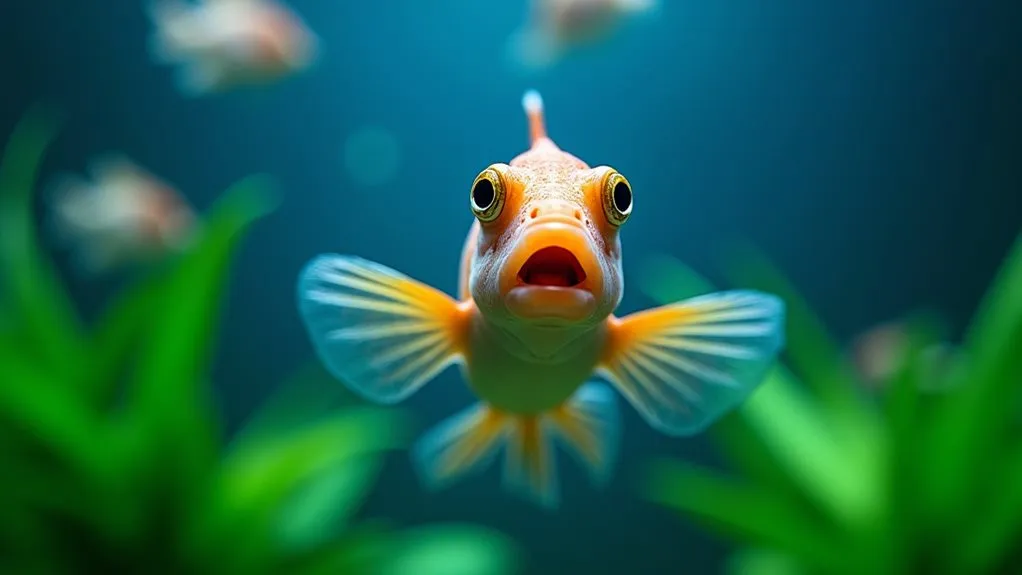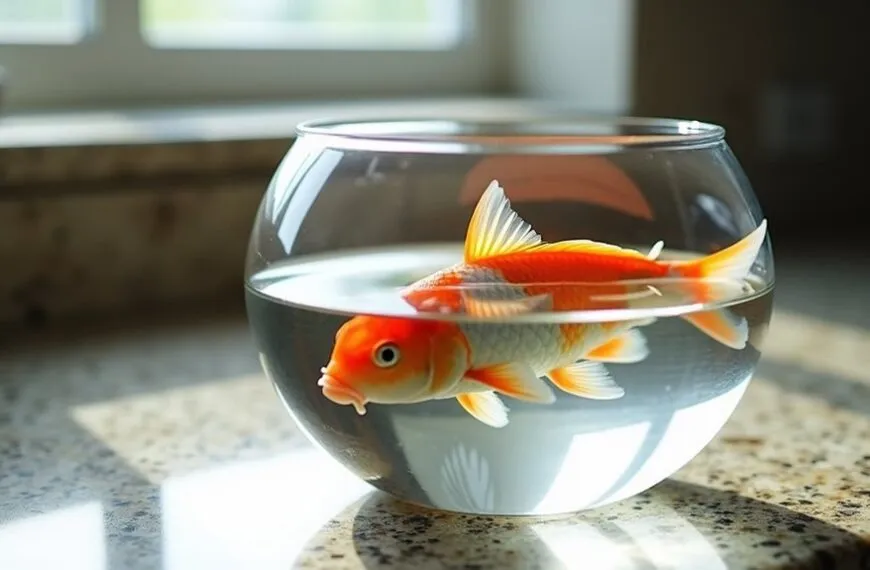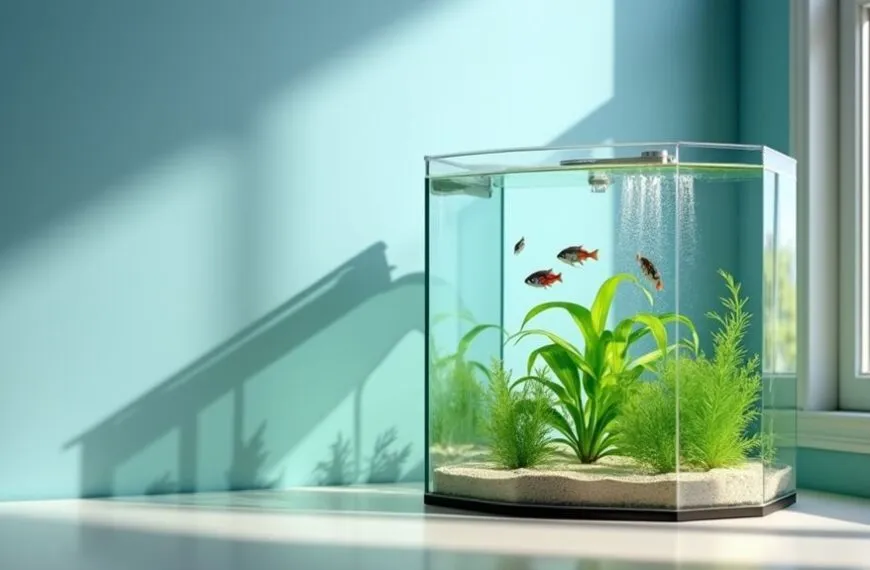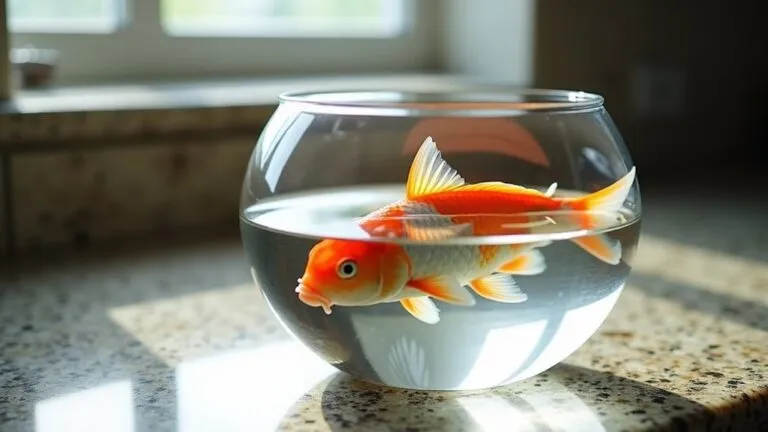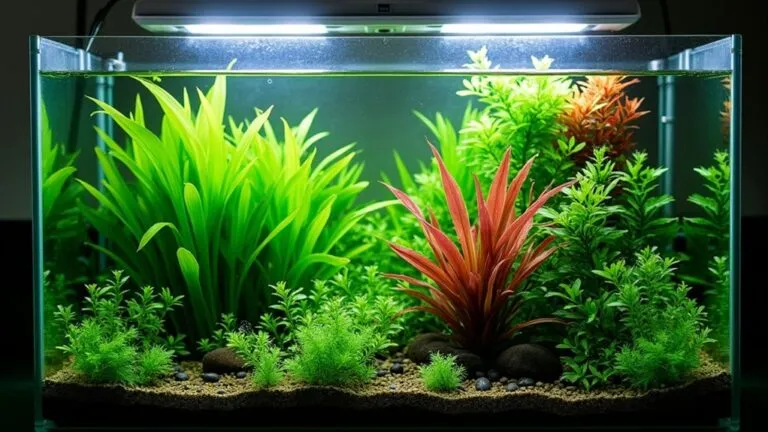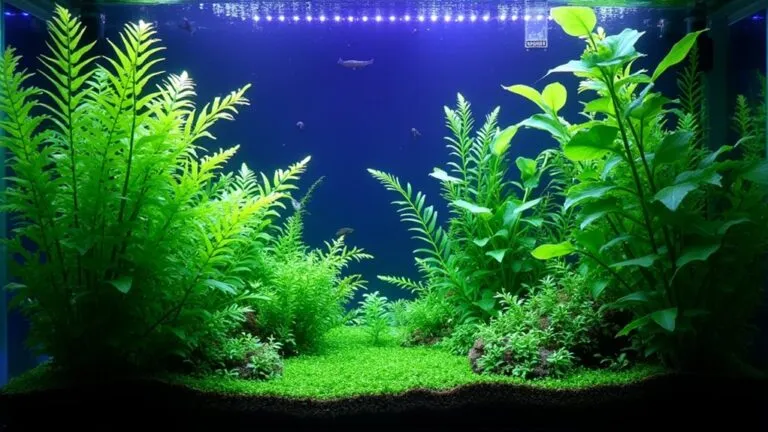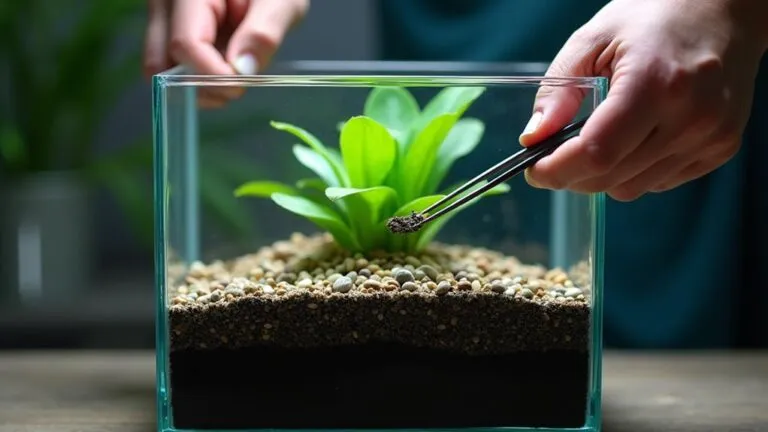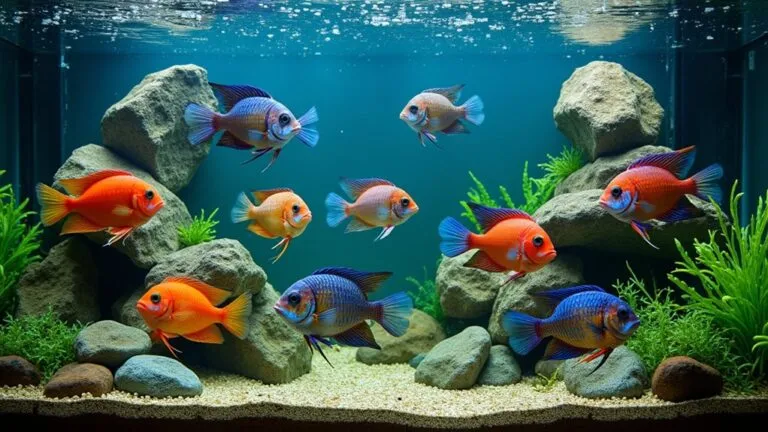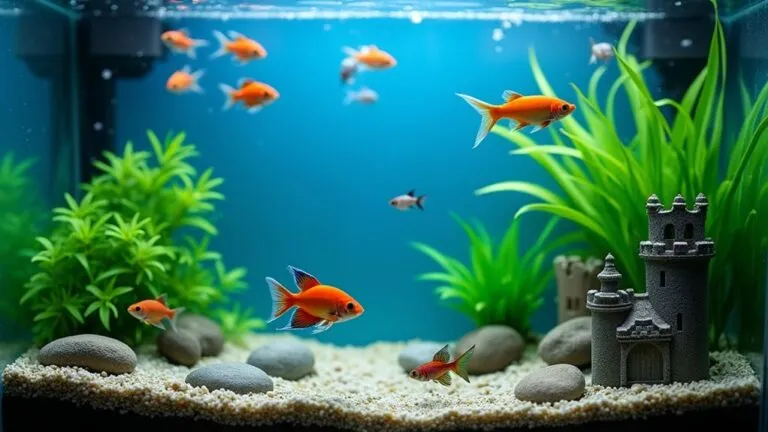Your fish will show clear signs when they're hungry, including swimming more actively near the surface and following you around the tank like an excited puppy. You'll notice them gathering near their usual feeding spot and possibly nipping at plants or decorations. Healthy, hungry fish often create a feeding frenzy when food is offered, competing energetically at the surface. Watch for physical changes too – sunken bellies or dulling colors can mean it's definitely time for a meal. Most adult fish do well with one or two feedings daily, but understanding your specific fish's needs will help you become the perfect fish parent.
Contents
- 1 Common Signs of Fish Hunger
- 2 Understanding Fish Feeding Patterns
- 3 Physical Changes When Fish Starve
- 4 Behavioral Indicators During Feeding Time
- 5 Proper Feeding Schedule
- 6 Managing Multiple Fish Species
- 7 Tank Environment and Feeding
- 8 Watch for These Warning Signs
- 9 Best Practices for Fish Nutrition
- 10 Long-Term Effects of Malnutrition
- 11 Frequently Asked Questions
- 11.1 Can Different Water Temperatures Affect How Often My Fish Needs Feeding?
- 11.2 Do Fish Need Different Foods During Breeding Season?
- 11.3 Should I Feed My Fish Differently After Treating Them With Medication?
- 11.4 How Long Can Most Aquarium Fish Survive Without Food?
- 11.5 Do Fish Need Vitamin Supplements if I'm Feeding Them Quality Food?
- 12 Final Thoughts
Common Signs of Fish Hunger
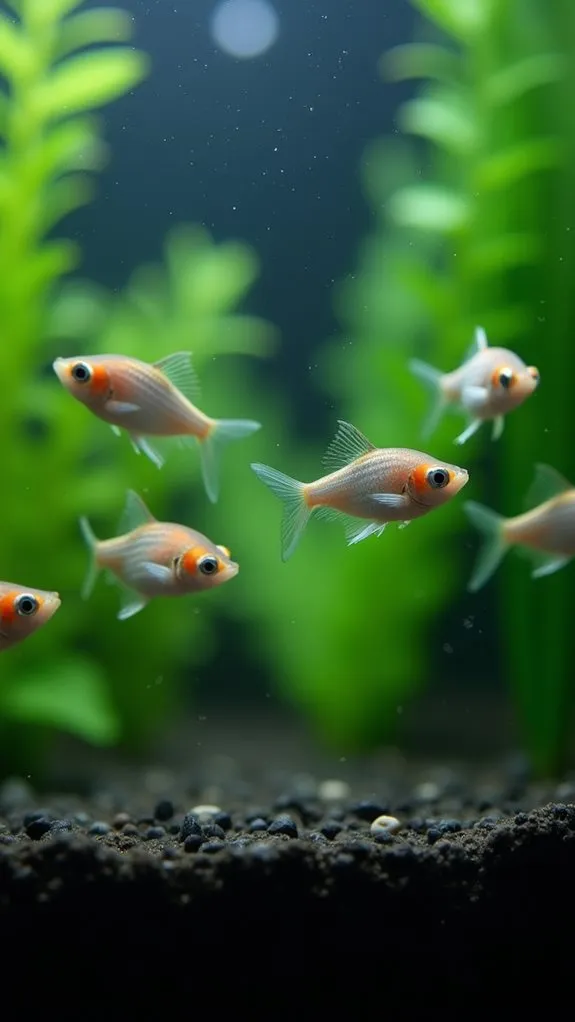
Knowing when your fish are hungry requires careful observation of their behavior and physical appearance. One of the most reliable hunger cues you'll notice is increased activity near the surface, especially during regular feeding times. You'll see your fish swimming faster and more enthusiastically when they're anticipating their next meal. Research shows that swimming speeds increase significantly in underfed fish populations. Additionally, fish that are part of species known for schooling behavior may show even more pronounced signs of excitement and hunger when they gather together near the surface.
Watch for specific feeding reactions that indicate hunger, like your fish following your movements or gathering in a tight group near where you typically feed them. Many fish can survive without food for several days, but they'll still display these hunger behaviors. If you notice your fish frantically picking at plants or substrate, or chasing each other more aggressively than usual, they're probably telling you they're ready for a meal.
Your normally peaceful herbivorous fish might even start nibbling at live plants – their version of raiding the pantry!
Physical signs can also reveal hunger: if your fish's belly appears sunken or their colors seem duller than usual, it's time for a feeding.
And here's a dead giveaway – if your fish practically do backflips whenever you approach the tank, they're definitely sending you a not-so-subtle message that dinner time can't come soon enough!
Understanding Fish Feeding Patterns
Just as you follow a natural schedule for your meals, your fish's feeding patterns are driven by their biological rhythms and daily cycles.
When water temperatures reach 65 to 75 degrees, fish tend to be most active and hungry. Additionally, many species, including tetras, thrive during these peak feeding times.
You'll notice that most fish are naturally hungrier during specific times of day, particularly at dawn and dusk when they're most active in their natural habitats.
Adult fish generally need one daily feeding to maintain proper nutrition and health. Understanding these natural feeding schedules will help you create the perfect mealtime routine for your finned friends and guarantee they're getting food when they're most likely to eat it.
Daily Feeding Schedules Matter
A proper feeding schedule forms the foundation of your fish's health and happiness. When it comes to feeding frequency and meal timing, you'll want to take into account several key factors that influence when and how often to feed your finned friends. Monitoring the amount given is crucial, as uneaten food should be removed promptly to maintain water quality. Most fish do well with once daily feeding, though younger ones may need more frequent meals. Regular water changes also help maintain the overall water quality that supports fish health.
Your fish's natural rhythms typically align with dawn and dusk, making these ideal feeding times. If you've noticed your fish getting extra active during these periods, they're following their instincts!
Water temperature plays a vital role too – in warmer water, your fish will have a heartier appetite and might need more frequent meals. During colder months, you can scale back the feeding schedule a bit.
Don't forget to watch for those telltale signs that it's mealtime. When your fish start swimming near the surface or showing more active behavior than usual, they're probably ready for their next meal. Just like us, they've got their own internal clocks!
Remember to establish consistent feeding times – your fish will quickly learn when to expect their meals, and you'll notice them gathering near the surface right on schedule.
Natural Instincts Drive Hunger
Every fish species follows distinct natural instincts that govern their feeding patterns. Just like you might crave breakfast at sunrise, your fish's natural instincts kick in during specific times, particularly at dawn and dusk when many species are most active. Fish can adapt to survive long periods without regular meals, as some freshwater eels can survive for over a year without eating.
These hunger triggers are deeply rooted in their biological programming, influenced by everything from moonlight to water temperature. Feeding requirements vary greatly between species, and maintaining optimal water parameters ensures that fish remain healthy and are more likely to show regular feeding behavior.
You'll notice your fish's behavior change when their natural feeding instincts take over. They might become more energetic during incoming tides if they're naturally coastal species, or they could be midnight snackers like catfish.
Environmental factors play a huge role too – warmer water typically gets their appetites going, while cooler temperatures might make them a bit pickier about mealtime.
If you've got different species in your tank, don't be surprised if they're hungry at different times – that's just their natural instincts at work! Understanding these patterns helps you become a better fish keeper, as you'll learn to recognize when your finned friends are truly ready for their next meal rather than just being opportunistic eaters.
Physical Changes When Fish Starve
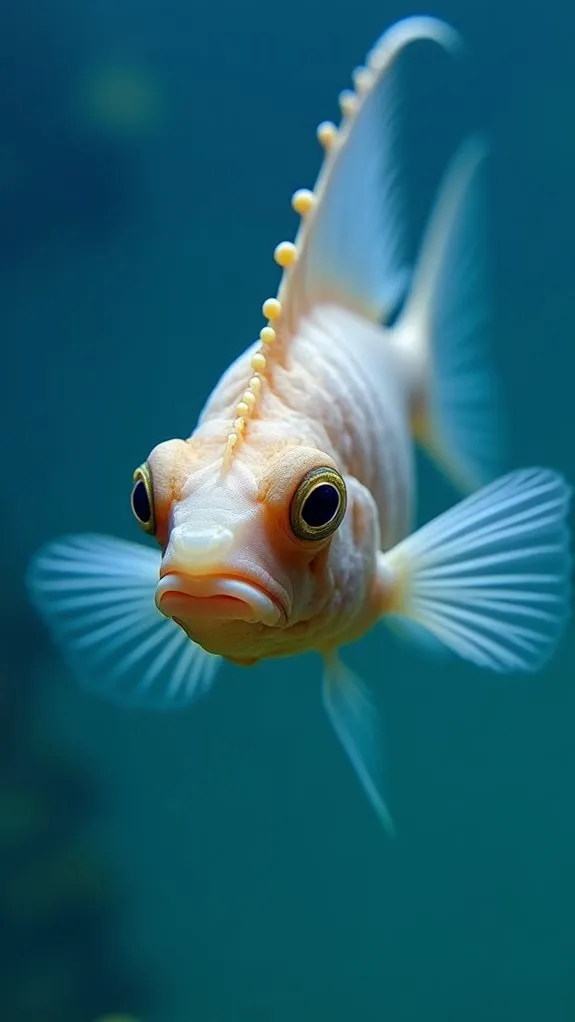
During periods of starvation, fish undergo several noticeable physical changes that can help you identify if they're underfed. The most obvious sign is weight loss, which happens when your fish's body starts using stored energy to maintain basic functions.
You'll notice your fish looking thinner than usual, and their overall body shape might appear less robust than it should be. Metabolic adjustments occur in fish when they face food deprivation, causing their bodies to adapt to the lack of nutrients. Similar to how muscle pH affects texture in healthy fish, a hungry fish's muscle tissue can become increasingly soft due to protein breakdown. Maintaining a clean and balanced environment is crucial, as water quality can influence the overall health and feeding behavior of fish.
Keep an eye out for your fish's belly area – a sunken or shrunken appearance is a telltale sign that they're not getting enough nutrition. If you're seeing bones where you usually see smooth contours, that's another red flag.
Well-fed fish should have a nicely rounded abdomen and vibrant coloring, while hungry fish often appear dull and lackluster.
These changes aren't just surface-level – they're affecting your fish's internal organs too. Their liver function can become compromised, and their immune system might weaken, making them more susceptible to illness.
That's why it's vital to maintain a proper feeding schedule and respond quickly if you notice these warning signs in your finned friends.
Behavioral Indicators During Feeding Time
Physical changes aren't the only way to determine if your fish needs food – their behavior during feeding time tells an equally important story. When you observe your fish during mealtimes, you'll notice several behavioral cues that indicate hunger. A classic sign is when your fish create a feeding frenzy, rushing to the surface and competing with each other for food like hungry teenagers raiding the fridge.
You'll know your fish are ready to eat when they become more active before their usual feeding times, almost like they're checking their watches. They might swim near the surface, follow you around the tank, or gather near their feeding spot with keen anticipation. If you notice them nipping at plants or decorations, they're probably telling you, "Hey, it's dinner time!"
However, watch out for concerning behaviors too. If your fish are breaking the water surface dramatically or bottom-feeders are swimming up to grab food, they might be underfed.
Similarly, if they're spitting out food or showing erratic swimming patterns, it could signal stress or illness rather than simple hunger. It's important to remember that each species has different care requirements when it comes to feeding, so understanding their specific needs can help you effectively gauge their hunger levels.
Proper Feeding Schedule
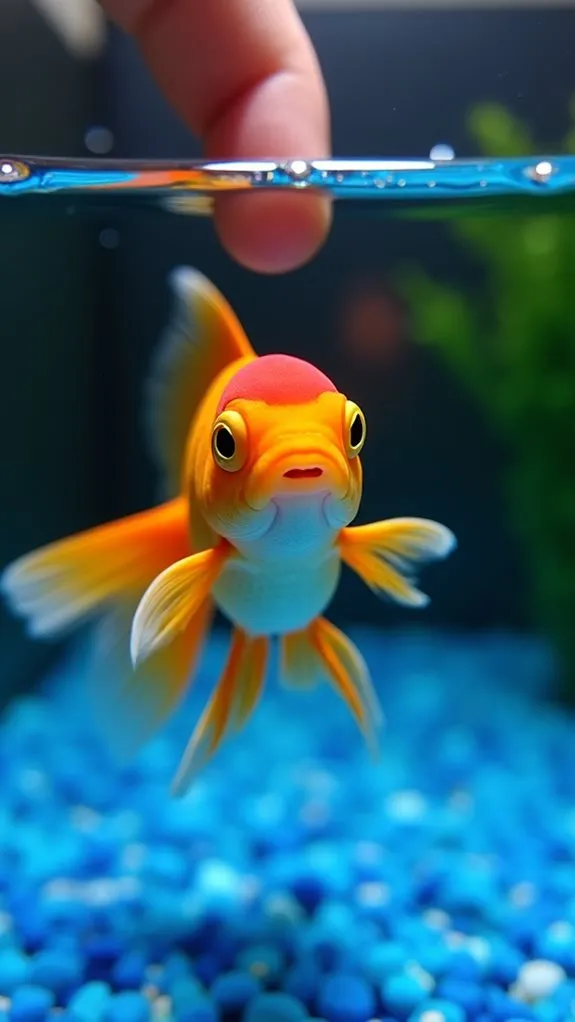
You'll want to time your fish's meals to match their natural feeding patterns, with most species doing well on one or two regular feedings per day. When you're dishing out their food, remember the five-minute rule: only offer what they can finish in that timeframe to prevent waste and water quality issues. Just like people, different fish species have their own unique dining preferences, so you'll need to adjust your feeding schedule based on whether you've got daytime eaters, night owls, or constant grazers in your aquarium. Providing a varied diet, including freeze-dried and frozen options, will help ensure your fish receive proper nutrition and maintain their vibrant colors.
Daily Feeding Time Guidelines
When establishing a proper feeding schedule for your fish, understanding the basic timing guidelines is essential for their health and well-being. Most aquarium fish do well with one or two feedings per day, but you'll need to adjust the feeding frequency based on your specific fish species and their unique needs.
For example, if you've got tropical fish, they'll typically thrive on 1-2 daily meals, while marine fish might need 2-3 feedings to maintain proper nutritional balance. You'll want to watch your fish's behavior closely to fine-tune their feeding schedule. If you notice them getting extra excited when you approach the tank or frantically searching for food among plants and decorations, they're probably ready for mealtime.
Remember, consistency is key – try to feed them at the same times each day. Think of it like setting up a dinner schedule for your family! Additionally, ensuring a balanced diet is crucial for your fish's well-being, as it helps prevent health issues and promotes longevity.
Temperature also plays a role in how often you should feed your fish. When the water's warmer, their metabolism speeds up, so they might need more frequent meals.
Just be careful not to overfeed – it's better to give smaller portions more often than one large feeding.
Meal Size Management
Managing proper meal sizes builds directly on your daily feeding schedule. To guarantee your fish stay healthy and happy, you'll need to make portion adjustments based on their activity levels and feeding behaviors. Just like how you might eat more after a workout, active fish need larger portions than their couch-potato cousins.
Keep a close eye on your fish during feeding times – they're actually pretty good at telling you what they need. If you notice your finned friends constantly swimming near the surface or following your every move around the tank, they might be sending you a "we're hungry!" message.
On the flip side, if they're showing less interest in food, you might want to scale back the portions. Your feeding observations are essential for maintaining the right balance.
Watch out for physical signs like sunken bellies or dull colors, which could mean you're underfeeding. If you've got herbivorous fish, they might need more frequent meals unless your tank is an underwater garden paradise. Consistent monitoring of water quality parameters helps ensure a stress-free environment where your fish can thrive and utilize their nutrients effectively.
Adapt Based On Species
Different fish species have unique dietary needs that require specific feeding schedules and approaches. When you're caring for tropical fish, you'll want to feed them once or twice daily, while marine fish typically need two to three meals per day. Understanding these species-specific needs is vital for keeping your underwater friends happy and healthy.
For herbivorous fish, like certain marine species, you'll need to provide frequent access to algae-based foods since they're natural grazers. If you've got carnivorous fish, they'll do better with one or two larger meals of protein-rich foods each day. Your community tank residents might need a mix of feeding styles to accommodate everyone's preferences.
Don't forget about those night owls! If you've got nocturnal fish like catfish, they'll appreciate their dinner served just before lights out.
Young fish and fry are like teenagers – they're always hungry and need more frequent meals, about three to four times daily. By paying attention to these feeding preferences and adjusting your schedule accordingly, you'll guarantee each fish gets exactly what they need when they need it. Additionally, always monitor the water quality in the tank, as poor conditions can also affect your fish's appetite.
Managing Multiple Fish Species
Successful aquarium maintenance requires a thoughtful approach to managing multiple fish species. When you're monitoring feeding behaviors, you'll need to take into account fish compatibility and territorial behavior to guarantee everyone gets their fair share at mealtime. Think of it like managing a dinner party where some guests are pickier than others!
To maintain harmony in your aquatic community, you'll want to observe how different species interact during feeding time. Some fish are natural bottom feeders, while others prefer to eat at the surface. If you notice more aggressive fish preventing others from accessing food, you might need to create separate feeding zones or adjust your feeding schedule.
It's particularly important when you have African Cichlids, who can be quite territorial during meals.
Don't forget to match fish with similar dietary needs when stocking your tank. You wouldn't want to mix strict herbivores with carnivores – that's like seating a vegan next to a steak enthusiast!
Keep detailed records of feeding patterns and behaviors, and be ready to make adjustments if you notice any fish aren't getting enough to eat.
Tank Environment and Feeding
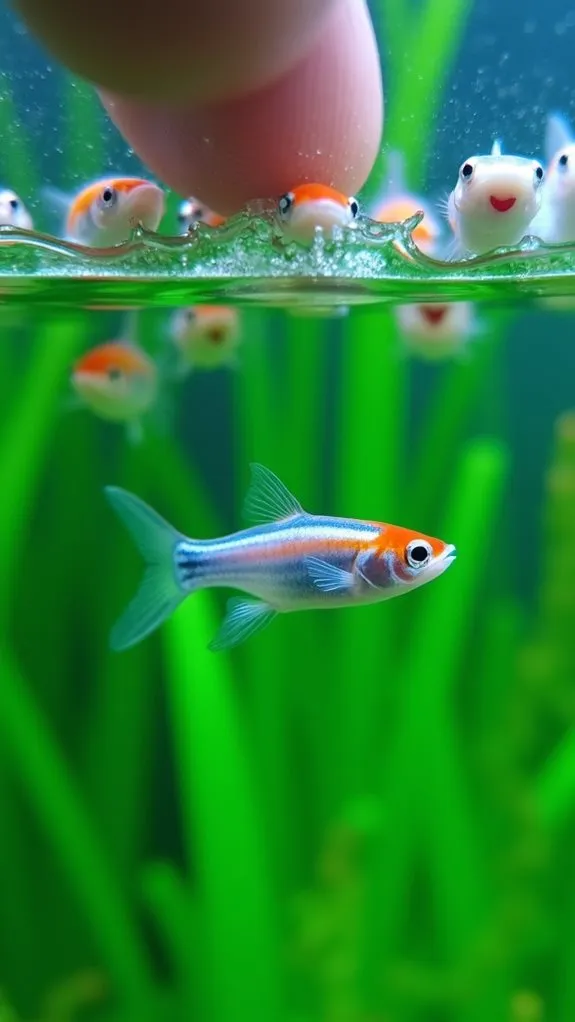
Your tank's environment plays an essential role in your fish's feeding behavior and appetite. Proper tank maintenance and consistent water quality checks guarantee your finned friends maintain healthy eating habits.
Just like you wouldn't want to eat in a messy kitchen, fish won't thrive in poor water conditions.
Here's what you'll need to monitor to create the perfect dining environment for your fish:
- Keep water parameters stable – fluctuations in temperature or pH can stress your fish and reduce their appetite.
- Maintain regular cleaning schedules – excess waste can impact water quality and make your fish less interested in food.
- Create appropriate lighting conditions – especially important for nocturnal species who prefer dining in darker settings.
Watch for These Warning Signs
Once you've established the right tank environment, recognizing the signs of hunger will help you feed your fish appropriately. Pay attention to your fish's behavior during regular feeding times – if they're darting to the surface or following your movements more keenly than usual, they might be telling you they're ready for a meal.
Watch for concerning physical signs that could indicate you're not getting the feeding frequency right. If your fish's belly appears sunken or their colors seem duller than normal, they mightn't be getting enough food.
On the flip side, you don't want to give in to their adorable "puppy dog eyes" act every time they beg for food – fish are natural opportunists and will often act hungry even when they're well-fed!
The key is finding the right balance. Notice how your fish react when you approach the tank – while excitement is normal, excessive begging or aggressive behavior during feeding times might mean you need to adjust their meal schedule.
Best Practices for Fish Nutrition
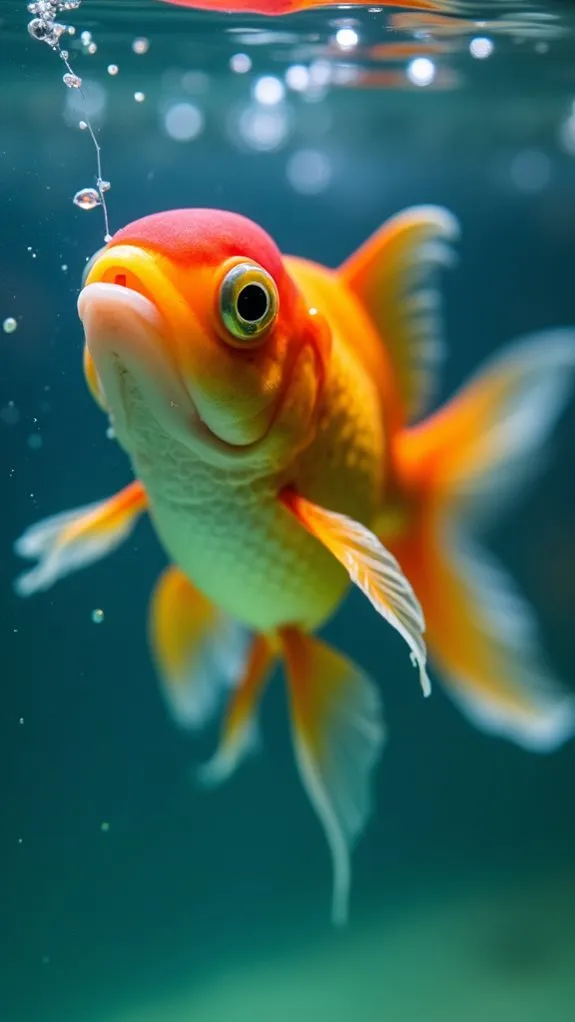
Proper nutrition forms the foundation of a healthy aquarium ecosystem. When you're feeding your fish, it's crucial to maintain the right nutrient balance by offering high-quality commercial feeds that meet their specific protein and energy needs.
You'll find that different species have varying requirements – herbivores need less protein than their carnivorous cousins, who might need up to 50% protein in their diet.
To master effective feeding techniques, consider these key practices:
- Feed your fish 2-3 times daily on a consistent schedule – they'll actually learn to recognize you as their food provider!
- Match the feeding method to your fish's natural habits, whether they're bottom dwellers or surface swimmers.
- Watch portion sizes carefully – it's better to feed slightly less than to overdo it and risk water quality issues.
Long-Term Effects of Malnutrition
Understanding the long-term effects of malnutrition in fish reveals a cascade of serious health issues that can devastate your aquarium population. If you're not providing proper nutrition, your fish won't just be hungry – they'll face severe malnutrition consequences that can impact their entire lives.
When your fish don't get the nutrients they need, their immune systems take a major hit. You'll notice they're more likely to catch diseases, and problems like fin rot can become a recurring nightmare.
Those beautiful, vibrant colors you love? They'll fade away, leaving your fish looking dull and lifeless. Think of it like a domino effect – one nutrient deficiency leads to another problem, and before you know it, your fish are struggling to swim normally or even survive.
Specific vitamin deficiencies can cause particularly troubling issues. If your fish aren't getting enough vitamin B, they might start swimming erratically or develop muscle problems.
A lack of essential fatty acids can leave them vulnerable to illness, while missing out on nutrients like niacin or biotin can slow their growth to a crawl. It's not just about keeping them fed – it's about keeping them healthy for the long haul.
Frequently Asked Questions
Can Different Water Temperatures Affect How Often My Fish Needs Feeding?
Yes, water temperature directly affects your fish's feeding frequency. When it's warmer, you'll need to feed more often (up to 4 times daily), but in colder water, you'll reduce feedings as their metabolism slows down.
Do Fish Need Different Foods During Breeding Season?
You'll want to adjust your fish's diet during breeding season, as their breeding behavior often increases energy needs. While food preferences stay similar, you should offer more protein-rich foods and frequent meals.
Should I Feed My Fish Differently After Treating Them With Medication?
After medication, you'll need to adjust your fish's diet by offering immune-boosting foods. Start with small portions to guarantee they're eating well, as medication effects can temporarily impact their appetite.
How Long Can Most Aquarium Fish Survive Without Food?
Most aquarium fish can survive 3-7 days without food, but feeding frequency depends on species, age, and size. You'll want to maintain regular meals to prevent hunger signs and keep your fish healthy.
Do Fish Need Vitamin Supplements if I'm Feeding Them Quality Food?
No, you don't need vitamin supplements if you're feeding quality fish food. Commercial foods already contain essential vitamin sources. Adding supplement types unnecessarily can actually harm your fish through over-supplementation.
Final Thoughts
You're now equipped to be a more attentive fish parent! Remember to watch for those telltale signs of hunger, like begging behavior and increased activity during feeding times. By maintaining a consistent feeding schedule and monitoring your fish's behavior, you'll develop a better understanding of their needs. Don't forget that a well-fed fish is a happy fish, and your underwater friends will thank you with their vibrant colors and lively personalities!

